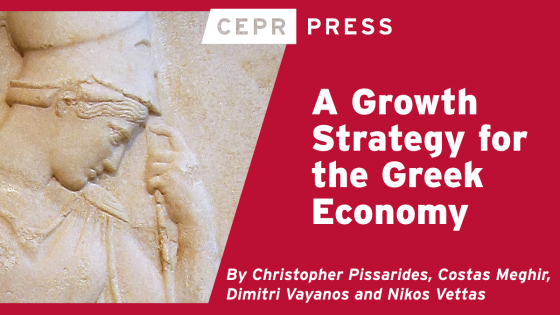The possibility of the UK leaving the EU has generated an unusual degree of consensus among economists. Acrimony and rancour surrounded debates around austerity and joining the euro, but analysis from the Bank of England, to the OECD, to academia has all shown that Brexit would make us economically worse off. The disagreement is mainly over the degree of impoverishment (e.g. Dhingra et al. 2016a, OECD 2016, HM Treasury 2016, PwC 2016, NIESR 2016).
The one exception is the much recent and publicised work of ‘Economists for Brexit’ (2016). Since the economic case for leaving the EU has been largely missing in action, it is refreshing to get some clarity over the Leave campaign’s vision of the UK’s post-Brexit economic arrangements.
The only modelling details provided by Economists for Brexit come from Professor Patrick Minford of Cardiff University, who argues that Brexit will raise the UK’s welfare by 4% as a result of increased trade (Minford 2015, 2016, Minford et al. 2016).
So where exactly does he get his numbers from and why are they so different?
The ‘Britain Alone’ policy: A hard political sell?
Minford’s policy recommendation is that following a vote for Brexit, the UK should not bother striking new trade deals but instead unilaterally abolish all its import tariffs (let’s call this policy ‘Britain Alone’). The UK would simply pay the tariffs imposed by other countries on UK exports. This is usually the worst-case scenario that other economists have examined.
This would be a pretty hard sell to UK citizens. Minford admits his model predicts that the policy would cause the ‘elimination’ of UK manufacturing and a large increase in wage inequality. But although he is relaxed about these outcomes, we suspect that voters in Port Talbot and elsewhere in Britain wouldn’t be so impressed.
Indeed, we know of no cases where an industrialised country has ever implemented full unilateral liberalisation – and for good reason. Persuading other countries to reduce their trade barriers is easier if you can also say you’re going to reduce your own as part of the deal. If we’re committed to going naked into the world economy, other countries are unlikely to follow suit voluntarily.
But putting political reality aside, standard economics does suggest some benefits from ‘unilateral trade disarmament’. For example, in our work back in March (Dhingra et al. 2016a, Table 2) we also look at what would happen if the UK eliminated all tariffs after Brexit. Looking solely at the short-run static effects, we find that if the UK trades under WTO rules following Brexit, but maintains import tariffs, income per person falls by 2.6%. Under the ‘Britain Alone’ scenario of unilateral liberalisation after Brexit, UK real incomes still fall by 2.3%. In other words, there is a gain of only 0.3 percentage points from eliminating tariffs compared to just trading under WTO rules and the British people are still considerably worse off as a result of Brexit. The mystery is why Minford can generate effects thirteen times are large.
Method a la Minford
There are basically two steps in Minford’s analysis. First, he assumes that feed from EU trade protectionism, prices paid by UK consumers for manufacturing and agricultural goods would fall by 10% under ‘Britain Alone’. Second, he feeds this fall in trade costs into his ‘Liverpool model’ to come up with a GDP increase of 4%.
The 10% number does not come from looking at the actual level of tariffs, which are only around 3%. Rather, it comes from looking at the differences in price levels between the UK and some other countries using data that is 14 years out of date, and arguing that these higher prices are entirely due to EU trade barriers.
This is really far-fetched. Cross-country price differences are due to a number of factors, particularly different tastes and quality. For example, say Europeans put a higher premium on high-quality clothing compared with Americans. It will look like Europeans are paying more for their clothes, but in reality, the higher average prices simply reflect a different mix of purchases – we are just comparing apples with oranges across countries (Deaton 2014).
Minford misunderstands the nature of regulations and product standards. The idea of the Single Market is to have common rules so that a product sold in one EU country can also be sold in any other. If there are 28 different sets of rules governing the sale of a product, it will be harder to sell these products across all EU countries. Minford sees the harmonisation of regulations as a pernicious plot by vested interests to raise prices. But playing by a common set of rules is what helps increase trade and competition in a modern economy.
It is true that tougher European standards for product safety and quality keep out some trade. For example, if after Brexit the UK reduced the levels of safety in children’s toys to those of sold domestically in China, the average price of children’s toys would fall. But this is because the safety standards would deteriorate – quality adjusted prices would not change much. This is hardly the kind of price fall that generates welfare gains.
How Minford defies the laws of gravity
Trade flows increase as the economic size and average wealth of countries grows, and decrease with rising costs of trade between them caused by import tariffs, transport costs and other trade barriers. This is an empirical regularity called the ‘gravity’ relationship, and it is the statistical bedrock of modern trade models.
Minford uses a 1970s-style trade model in which all firms in an industry everywhere in the world produce the same goods and competition is perfect. There is no product differentiation – a German-made car is identical to a Chinese-made car. Importantly, trade does not follow the gravity equation – everyone simply buys from the lowest cost producer.
As a consequence, after Brexit, the UK does not care about the tariff barriers exporters face in accessing the EU Single Market as they can sell as much as they like anywhere in the world. The fact that France is closer than Fiji essentially makes no difference in the Minford world – there is just one fictional world market into which all goods can be effortlessly sold.
If this sounds crazy, that’s because it is crazy.
In reality, the UK will still continue to trade extensively with our closest geographical neighbours, it’s just that the higher trade barriers mean that we will do less of it.
Comparing Minford’s approach with modern trade models
Modern trade models like the one we use in Dhingra et al. (2016) are ‘computable general equilibrium models’ like Minford’s. But they build in the gravity relationship, so do not have the extreme magnifying force of welfare gains from unilateral trade liberalisation. This is why we find that ‘Britain Alone’ only generates modest offsets to the losses of trade with our main partners.
All models simplify. But when the simplifications imply that the EU has created no new trade, despite the abundance of evidence (e.g. Magee 2008, HM Treasury 2016) to the contrary, it is the theory that must go back to the drawing board, not the data.
Our work and that of the other economic studies relies on data that show what has actually happened to trade after joining the EU, rather than just asserting what should happen in a theoretically dubious model.
Minford’s style of work was popular in some quarters in the 1970s. In those days, economics did not need to be well-grounded in facts and data, and could rely on highly simplified theories. The revolution over the last 40 years has been the explosion of data and empirical techniques for its analysis.
Minford’s attitude seems to be that if empirical work is imperfect, it should be ignored. Of course there are issues with all empirical work. Some of these problems might mean we over-estimate the EU’s effect on trade and foreign investment; some might mean we underestimate it.
But to take the position that since no econometric work can be perfect, all inconvenient facts should be ignored is poor scholarship and bad science.
Summing up
Alternative economic models have different advantages and drawbacks and are suited for different purposes. Unfortunately, Minford’s model is inconsistent with two basic facts about international trade: first, that trade satisfies the gravity equation; and second, that the EU has been trade-creating, not simply a tool for trade diversion.
This implies that the model will give very unreliable predictions of the consequences of Brexit for trade and living standards. When we analyse the same scenario considered by Minford using a more realistic assessment of how UK ‘unilateral trade liberalisation’ could actually work, we find (alongside just about everyone else) that Brexit still leads to a decline in UK living standards.
Minford’s ‘Liverpool model’ with its 1970s vintage of perfect markets everywhere has a bad track record when it comes to policy analysis. For example, in 1997 the model predicted that the proposed national minimum wage would mean millions more unemployed. Subsequent evaluations of the minimum wage have shown that the actual effect was rather less – zero, in fact (Metcalf 2008).
Like the other 1970s hit, we won’t get fooled again.
References
Baier, S.L., J.H. Bergstrand, P. Egger and P.A. McLaughlin (2008) ‘Do Economic Integration Agreements Actually Work? Issues in Understanding the Causes and Consequences of the Growth of Regionalism’, The World Economy 31(4): 461-97.
Deaton, A. (2014) ‘Getting Prices Right: The Mysteries of the Index’, LSE Lionel Robbins Memorial Lectures.
Dhingra, S., G. Ottaviano, T. Sampson and J. Van Reenen (2016) ‘The Consequences of Brexit for UK Trade and Living Standards’, CEP Brexit Analysis No. 2.
Economists for Brexit (2016) ‘The Economy After Brexit’.
HM Treasury (2016) ‘The Long-term Economic Impact of EU Membership and the Alternatives’, London: HMSO
Magee, C. (2008) ‘New Measures of Trade Creation and Trade Divergence’ Journal of International Economics 75(2), 349-62.
Metcalf, D. (2008) ‘Why has the British National Minimum Wage had little or No Impact on Employment?’ Journal of Industrial Relations 50: 489-512.
Minford, P. (2015) ‘Evaluating European Trading Arrangements’, Cardiff Economics Working Paper No. E2015/17.
Minford, P. (2016) ‘Understanding UK Trade Agreements with the EU and Other Countries’, Cardiff Economics Working Paper No. E2016/1.
Minford, P., S. Gupta, V. Le, V. Mahambare and Y. Xu (2016) Should Britain Leave the EU? An Economic Analysis of a Troubled Relationship, Second Edition, IEA.
NIESR (2016) ‘The Economic Consequences of Leaving the EU’, May Special Issue.
OECD (2016) ‘The Economic Consequences of Brexit: A Taxing Decision’, OECD.
PWC (2016) ‘Leaving the EU: Implications for the UK Economy’.







